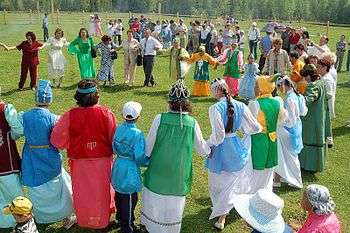Yhyakh
| Yhyakh | |
|---|---|
|
Feeding the fire at Yhyakh Festival. | |
| Observed by | Yakut |
| Significance | Start of the year |
| Observances | Festivals, Ohuokhai dance, family and other social gatherings, symbolic decorating |
| Date | June (variable days) |
| Related to | Tsagaan Sar |
Yhyаkh (Sakha: Ыhыах) is the New Year holiday in Sakha Republic.
Celebration
Sakha people celebrate the New Year twice a year – in winter with the rest of citizens of Russia, and in summer – according to the ancient traditions. Yakutia is the largest region of Siberia, almost all of its territory is situated in the Arctic Circle. Sometimes the temperatures reach -60 °C. Summer is very short, it lasts only three months. It begins in the middle of June. And the holiday is celebrated this time of year.
The Sakha Yhyakh festival (literally it can be translated as abundance) is related to a cult of a solar deity, with a fertility cult. Before the German invasion of the Soviet Union it was held on 22 June, the longest day of the year. But after 1941, for moral reason (the date of Yhyakh coincided with the beginning of Operation Barbarossa) it began to be spent in the period between 10 and 25 June.
Ancient Sakha celebrated the New Year at the Yhyаkh festival. Its traditions include women and children decorating trees and tethering posts with "salama" (nine bunches of horse hair hung on horse-hair ropes). The oldest man, wearing white, opens the holiday. He is accompanied by seven virgin girls and nine virgin boys and starts the ritual by sprinkling kymys on the ground, feeding the fire. He prays to the Ai-ii spirits for the well-being of the people who depend on them and asks the spirits to bless all the people gathered.
Afterwards, people sing and dance Ohuakhai (see below), play national games, eat national dishes, and drink kymys.
During the years of stagnation these traditional ceremonies were almost forgotten. Now there is a revival of Sakha culture, including the yhyakh festival. Until 1990, when the first yhyakh was held in Yakutsk, traditionally accurate celebrations were only held in some regions.
Ohuokhai Dance

The Ohuokhai dance appeared long ago when the Sakha people lived in the South and were typical cattle-breeders, so-called sun worshippers. It is a native dance that combines three forms of art: dancing, singing and poetry. The Sakha word "yungkyu" (Yңкүү, dance) comes from the verb "ungk" (Yң, to worship).
The Ohuokhai is a simultaneous round dance and song. Dancers form a circle and dance, arm in arm, hand in hand, with the left foor put forward, while making rhythmical, graceful movements with their bodies, legs, feet and arms. A lead singer improvises the lyrics and the other dancers repeat them. This Ohuokhai leader has a special talent not only for singing but also, what is more important, for poetic improvisation. There song leaders compete at the national Yhyakh festival for the best poetic expression, best song and biggest circle.
Poetic improvisation of the Ohuokhai represents one of the richest and oldest genres of Sakha folklore.
The melody of the Ohuokhai is put to many types of music, from marching tunes to operas. Kylyhakh is the special singing technique of vocal cord vibration. This technique gives a unique national Sakha colouring highly appreciated by experts in "throat singing". The Ohuokhai plays an important role in the development of the musical and choreographic arts.
A famous folk singer, poet and composer, Sergey Zverev from the Suntarsky region added many new elements in the expressiveness of the movements.
References
- Дидактический материал "Национально-региональный компонент на уроках английского языка" – Шамaева М.И., Семенова В.Д., Ситникова Н.В., Якутск 1995. (Didactic material "the National-regional component at lessons of English language" – Shamaeva M. I, Semenova V. D, Sitnikova N.V., Yakutsk 1995.)

